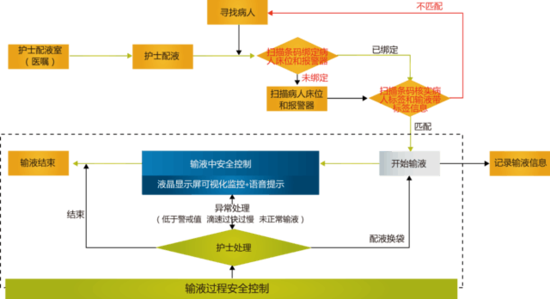Huawei Wireless IoT Brings Yinjiang Smart Medical to Create Mobile Infusion Monitoring System
In the daily work of the hospital, intravenous infusion is the most common treatment in clinical practice, but there is a rather annoying problem that has plagued health care workers, patients and their families, that is, the problem of “infusion safetyâ€. The infusion nurse is performing an infusion every day. Once the patient has an infusion complication, is sensitive to the infusion reaction, or is not timely, the nurse is likely to be the object of blame, and in fact the nurse is completely unaware of it. In recent years, the hospital transfusion medical negligence has caused a lot of accidents, medical disputes, so the infusion of these cases has exposed a general one-time infusion of congenital defects and safety risks in the operation of the infusion. Ensuring the safety of infusion is the focus of ward care management, which can effectively reduce the occurrence of nursing errors and disputes, improve patient satisfaction, and improve the social effects of hospitals.
Causes of safety hazards in hospital intravenous infusion
Objective factors :
The infusion environment in the ward is relatively complicated, and the wards are separated from each other. The contact with the nurse station can only be patrolled by family members or nurses; the infusion process in the ward is very complicated, and the informatized hospital cannot guarantee an effective three-check. Seven pairs.
Subjective factors:
Patients in the ward are slow to call for help, relying too much on the patient or family; lack of knowledge of the patient: self-regulation of the rate of droplets according to their own time; patients with multiple groups of infusions have misunderstood the doctor's advice, and have not terminated the infusion by the nurse himself, missing treatment.
Huawei Wireless Internet of Things with Yinjiang Smart Medical Mobile Infusion Monitoring System
Based on the above-mentioned safety hazards that are prone to occur in intravenous infusion, only the safety awareness of the infusion depends on the patient's active operation, and there are often omissions. The safety in the infusion process cannot be well guaranteed, and the reliability is not high. In the medical care market, a two-way interaction between nurses and patients is needed to achieve effective integration of all aspects of clinical care in the ward, to solve the problem of infusion safety, and to make it a typical example of hospital information construction. Huawei's full wireless coverage & Yinjiang mobile infusion monitoring system came into being. The key technology uses wireless coverage and RFID mobile identification technology to realize an advanced, innovative and perfect monitoring system, which brings infusion care for hospital wards. Reliability, safety, convenience, and practicality.
Key technology
Full wireless coverage
The density of the hospital ward is large, the wall environment is complex, and the signal coverage requirements cannot be dead. It is necessary to go through the actual site survey on the site, and adapt to local conditions, and deploy wireless Wi-Fi coverage to ensure wireless deployment in all areas of the hospital. Huawei's seamless roaming technology ensures that medical staff can quickly and smoothly switch between different APs in the context of ward activity, and the service is uninterrupted, thus achieving seamless roaming in the hospital, truly satisfying wireless ward, mobile care and other services. Interrupted, no re-certification requirements. At the same time, due to the IoT application of mobile infusion, Wi-Fi networks are required to seamlessly connect to the Internet for unified management.
RFID radio frequency identification technology
RFID radio frequency identification technology is a non-contact automatic identification technology that began to emerge in the 1990s. Radio frequency identification technology is a non-contact information transmission through spatial coupling (alternating magnetic field or electromagnetic field) using radio frequency signals. The information reaches the technology for identification purposes. It automatically recognizes the target object and acquires relevant data through the RF signal, and the identification work can work in various harsh environments without manual intervention. RFID technology can recognize high-speed moving objects and recognize multiple labels at the same time, which is quick and easy to operate. As one of the key technologies for medical IoT applications.
Huawei Brings Yinjiang Smart Medical to Build Mobile Infusion Monitoring System

Figure 1: Mobile infusion monitoring business function diagram
Different kinds of plant extracts contain different effective ingredients, and different effective ingredients are used in different products. Health-care Plant Extract products contain a certain amount of functional ingredients, which can regulate the functions of the human body, have specific effects, and are suitable for specific groups of people. .
Health food cannot be directly used to treat diseases. It is a human body mechanism regulator and nutritional supplement. The minerals of the human body are not balanced, and health products have great advantages in fixed health functions.
Herbal Powder,Herbal Extract,Plant Root Extract,Health Care Grade
Amazy Organic Biotech Co.,Ltd , https://www.amazyorganic.com